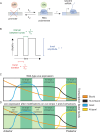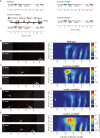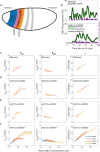Unified bursting strategies in ectopic and endogenous even-skipped expression patterns
- PMID: 39651963
- PMCID: PMC11627552
- DOI: 10.7554/eLife.88671
Unified bursting strategies in ectopic and endogenous even-skipped expression patterns
Abstract
Transcription often occurs in bursts as gene promoters switch stochastically between active and inactive states. Enhancers can dictate transcriptional activity in animal development through the modulation of burst frequency, duration, or amplitude. Previous studies observed that different enhancers can achieve a wide range of transcriptional outputs through the same strategies of bursting control. For example, in Berrocal et al., 2020, we showed that despite responding to different transcription factors, all even-skipped enhancers increase transcription by upregulating burst frequency and amplitude while burst duration remains largely constant. These shared bursting strategies suggest that a unified molecular mechanism constraints how enhancers modulate transcriptional output. Alternatively, different enhancers could have converged on the same bursting control strategy because of natural selection favoring one of these particular strategies. To distinguish between these two scenarios, we compared transcriptional bursting between endogenous and ectopic gene expression patterns. Because enhancers act under different regulatory inputs in ectopic patterns, dissimilar bursting control strategies between endogenous and ectopic patterns would suggest that enhancers adapted their bursting strategies to their trans-regulatory environment. Here, we generated ectopic even-skipped transcription patterns in fruit fly embryos and discovered that bursting strategies remain consistent in endogenous and ectopic even-skipped expression. These results provide evidence for a unified molecular mechanism shaping even-skipped bursting strategies and serve as a starting point to uncover the realm of strategies employed by other enhancers.
Keywords: D. melanogaster; chromosomes; development; developmental biology; enhancers; gene expression; imaging; patterning; transcription.
© 2023, Berrocal et al.
Conflict of interest statement
AB, NL, HG No competing interests declared, ME Michael B Eisen is former Editor-in-Chief of eLife
Figures







Update of
-
Unified bursting strategies in ectopic and endogenous even-skipped expression patterns.bioRxiv [Preprint]. 2024 Jun 25:2023.02.09.527927. doi: 10.1101/2023.02.09.527927. bioRxiv. 2024. Update in: Elife. 2024 Dec 09;12:RP88671. doi: 10.7554/eLife.88671. PMID: 36798351 Free PMC article. Updated. Preprint.
Similar articles
-
Unified bursting strategies in ectopic and endogenous even-skipped expression patterns.bioRxiv [Preprint]. 2024 Jun 25:2023.02.09.527927. doi: 10.1101/2023.02.09.527927. bioRxiv. 2024. Update in: Elife. 2024 Dec 09;12:RP88671. doi: 10.7554/eLife.88671. PMID: 36798351 Free PMC article. Updated. Preprint.
-
Synthetic enhancer design by in silico compensatory evolution reveals flexibility and constraint in cis-regulation.BMC Syst Biol. 2017 Nov 29;11(1):116. doi: 10.1186/s12918-017-0485-2. BMC Syst Biol. 2017. PMID: 29187214 Free PMC article.
-
Enhancer Control of Transcriptional Bursting.Cell. 2016 Jul 14;166(2):358-368. doi: 10.1016/j.cell.2016.05.025. Epub 2016 Jun 9. Cell. 2016. PMID: 27293191 Free PMC article.
-
One thousand and one ways of making functionally similar transcriptional enhancers.Bioessays. 2008 Nov;30(11-12):1052-7. doi: 10.1002/bies.20849. Bioessays. 2008. PMID: 18937349 Review.
-
Long-distance interactions between enhancers and promoters.FEBS J. 2005 Jul;272(13):3253-9. doi: 10.1111/j.1742-4658.2005.04757.x. FEBS J. 2005. PMID: 15978032 Review.
Cited by
-
Emerging roles of transcriptional condensates as temporal signal integrators.Nat Rev Genet. 2025 Aug;26(8):559-570. doi: 10.1038/s41576-025-00837-y. Epub 2025 Apr 16. Nat Rev Genet. 2025. PMID: 40240649 Review.
-
Regulation of Transcriptional Bursting and Spatial Patterning in Early Drosophila Embryo Development.bioRxiv [Preprint]. 2025 May 8:2025.05.02.651973. doi: 10.1101/2025.05.02.651973. bioRxiv. 2025. PMID: 40654818 Free PMC article. Preprint.
-
Gene activity fully predicts transcriptional bursting dynamics.ArXiv [Preprint]. 2024 Jun 28:arXiv:2304.08770v3. ArXiv. 2024. PMID: 37131882 Free PMC article. Preprint.
-
Optogenetic manipulation of nuclear Dorsal reveals temporal requirements and consequences for transcription.Development. 2025 Mar 15;152(6):dev204706. doi: 10.1242/dev.204706. Epub 2025 Mar 31. Development. 2025. PMID: 40018801 Free PMC article.
-
Enhancer Placement Impacts Transcriptional Dynamics in Drosophila Embryos.bioRxiv [Preprint]. 2025 Aug 16:2025.08.14.670187. doi: 10.1101/2025.08.14.670187. bioRxiv. 2025. PMID: 40832183 Free PMC article. Preprint.
References
MeSH terms
Substances
Associated data
- Actions
Grants and funding
LinkOut - more resources
Full Text Sources
Molecular Biology Databases

